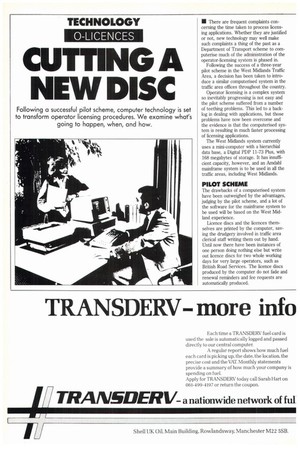CUTTING A NEW DISC
Page 60

Page 61

If you've noticed an error in this article please click here to report it so we can fix it.
Following a successful pilot scheme, computer technology is set to transform operator licensing procedures. We examine what's going to happen, when, and how.
• There are frequent complaints concerning the time taken to process licensing applications. Whether they are justified or not, new technology may well make such complaints a thing of the past as a Department of Transport scheme to computerise much of the administration of the operator-licensing system is phased in.
Following the success of a three-year pilot scheme in the West Midlands Traffic Area, a decision has been taken to introduce a similar computerised system in the traffic area offices throughout the country.
Operator licensing is a complex system so inevitably progressing is not easy and the pilot scheme suffered from a number of teething problems. This led to a backlog in dealing with applications, but those problems have now been overcome and the evidence is that the computerised system is resulting in much faster processing of licensing applications.
The West Midlands system currently uses a mini-computer with a hierarchial data base, a Digital PDP 11-73 Plus, with 168 megabytes of storage. It has insufficient capacity, however, and an Amdahl mainframe system is to be used in all the traffic areas, including West Midlands.
PILOT SCHEME
The drawbacks of a computerised system have been outweighed by the advantages, judging by the pilot scheme, and a lot of the software for the mainframe system to be used will be based on the West Midland experience.
Licence discs and the licences themselves are printed by the computer, saving the drudgery involved in traffic area clerical staff writing them out by hand. Until now there have been instances of one person doing nothing else but write out licence discs for two whole working days for very large operators, such as British Road Services. The licence discs produced by the computer do not fade and renewal reminders and fee requests are automatically produced. The publication Applications and Decisions is prepared on the computer, so applications are getting in two weeks faster than was previously possible.
The other main advantage of a computerised system is that it is possible to reach information much more quickly. The staff can answer requests far more rapidly using a VDU — and the response time will be even faster when the system becomes mainframe-based.
The West Midlands Traffic Area is currently the only traffic area in the country that can accurately say how many operator's licences, and of what type, are held in the area. Statistics required for the Licensing Authority's annual report can be readily produced, in a fraction of the time taken than when produced manually.
Last March 13,487 licences were held in the West Midlands, including 6,511 restricted, 5,761 standard national, and 1,209 standard national and international, specifying a total of 44,575 vehicles.
The information kept on the computer is governed by the provisions of the Data Protection Act. This information is basically the same as appears in Applications and Decisions; namely the operator's name and address, the operating centre(s), the type of licence, the vehicles and trailers specified and authorised, and (where appropriate) the name and address of the nominated transport manager.
Paper files still have to be kept on each operator to provide additional information and to act as a back-up should the computer go down.
Security is obviously an important consideration. Access to the public is physically restricted and there are passwords in the system to prevent someone from simply walking in and using a VDU to acquire information. When a member of staff leaves the passwords are changed.
As a back-up, in case of accidental erasure resulting in a loss of stored information, the data is stored on magnetic tape. Spare copies of the data bank tapes are kept in the Traffic Area building, with another set kept in an ouside strongroom, The actual mainframe computer to be used is the one installed at the DVLC, Swansea. Each traffic area office will have a dedicated line direct to Swansea. The South Wales Traffic Area will be the first to go "live" on the mainframe system, in about mid-1988, with the 10 other area offices following in succession, on a phased cycle.
South Wales is the smallest traffic area in the country and is the nearest to the DVLC, so its data-conversion problems are smaller than those of other areas.
DECISION MAKING
What the computerised system does not do is take over the decision-making process. The Licensing Authority and his staff will still make the day-to-day qualitative decision.
The validation process is still primarily clerical, though the computer will be used for part of that process. It will check whether the nominated transport manager has been nominated by any other operator, or whether a vehicle has been specified on more than one licence — such matters that were difficult to check when the system was wholly clerical.
A lot more information can be sourced from a computerised system than is possible with a wholly clerical system, enabling faster and better judgements to be made. One of the great advantages of the system is that if a mistake is made, the computer immediately points it out to the operative.
Though the Licensing Authorities will continue to be independent, there is likely to be a greater uniformity in the actual processing of applications throughout the country. That is bound to be an advantage to those operators with operating centres in more than one traffic area.
O by Mike Jewell




































































































































